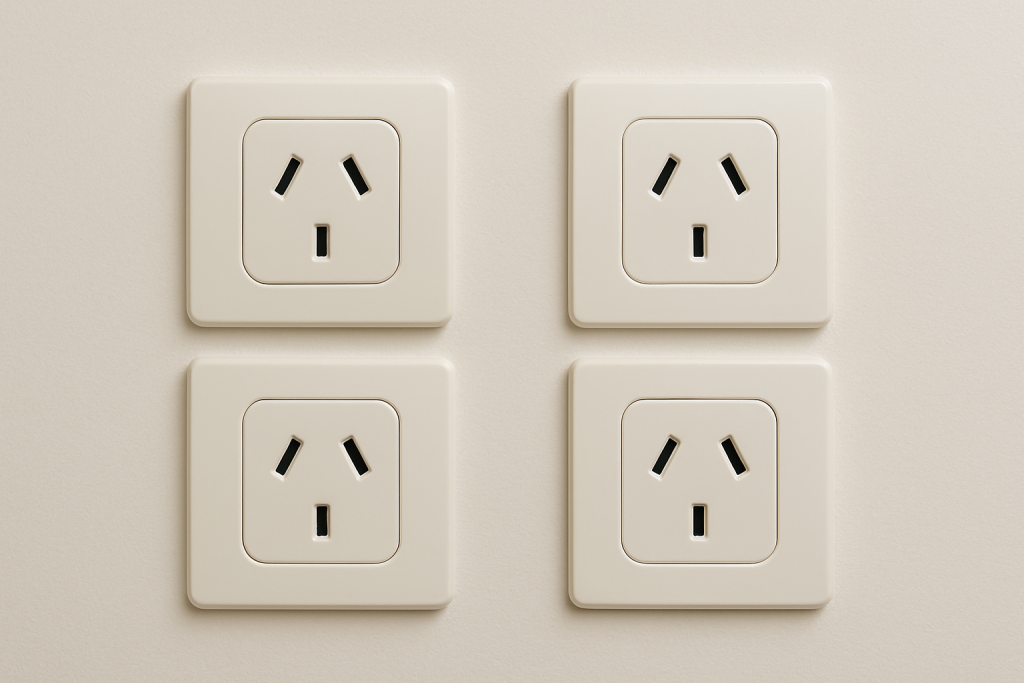
If your home’s power points are always in use, or worse, you’re constantly juggling extension cords and double adaptors. It might be time to rethink your electrical setup.
Many older Aussie homes were built at a time when we only had a few appliances. Fast forward to today, and we’re charging phones, running TVs, gaming consoles, air fryers, laptops, washing machines and more, often all at once. That’s a lot of demand on circuits that may not be designed for it.
Why Having the Right Number of Power Points Matters
Safety – Overloading a single outlet with double adaptors or power boards can trip your safety switches — or worse, cause a fire.
Convenience – No more crawling under beds or behind furniture to unplug one device so you can use another.
Energy Efficiency – New power points with USB or smart features can help reduce energy waste and make charging simpler.
Future-Proofing – Adding enough outlets now can save you the cost (and mess) of upgrading later.
General PowerPoint Guidelines
There’s no one-size-fits-all number, but here’s a general guide to help you estimate how many outlets each room should have:
Living Room
- Recommended: 4–6 double power points
- Consider spots for: TV, sound system, lamps, chargers, gaming consoles, Wi-Fi/router
- Tip: Add points behind the TV unit or in corners where furniture will sit
Kitchen
- Recommended: 6–8 power points (including appliances)
- Consider: kettle, toaster, microwave, fridge, coffee machine, blender
- Tip: Install extra outlets above benchtops for easy access while cooking
Bedrooms
- Recommended: 2–4 double power points per room
- Think: bedside lamps, phone chargers, fans, alarm clocks, TVs
- Tip: Place outlets near beds, desks, and wardrobes
Laundry
- Recommended: 2–3 outlets
- Consider: washing machine, dryer, and iron
- Tip: Ensure outlets are rated for wet areas and appliances with high power draw
Bathroom
- Recommended: 1–2 GPOs
- Consider: hairdryers, electric toothbrushes, shavers
- Tip: Make sure these are installed with proper IP ratings for wet zones
Home Office / Study
- Recommended: 4–6 outlets
- Think: computer, monitor, printer, modem/router, phone chargers
- Tip: Consider surge protection for sensitive electronics
Outdoor Areas
- Recommended: 1–3 weatherproof GPOs
- For: barbecues, garden tools, water features, outdoor lighting
- Tip: Use outdoor-rated enclosures for safety
Signs You Don’t Have Enough Power Points
- You’re constantly using double adaptors or power boards
- You’ve had tripping breakers or flickering lights
- You can’t plug in a new appliance without unplugging something else
- You have cords running across rooms (which are also a trip hazard)
- You’re planning a reno or adding a home office or media room
If any of these sound familiar, it’s a good time to chat with a licensed electrician.
Can You Just Add Power Points Anywhere?
Not quite. Power points must be:
- Installed by a licensed electrician (DIY is illegal and dangerous)
- Wired into the correct circuit
- Positioned in line with Australian Standards (AS/NZS 3000)
- Protected by a residual current device (RCD), especially in wet areas
At Airmelec, we don’t just add power points, we assess your home’s layout, power usage and safety switch setup to make sure everything runs safely and smoothly.
Future-Proof Your Home with Modern Power Points
Today’s outlets can do more than just power a lamp. Consider:
- USB power points for fast, clutter-free phone charging
- Smart power points you can control via app or voice assistant
- Pop-up or in-bench outlets for kitchens or studies
- Surge-protected outlets for sensitive electronics
Ask us about options that suit your home, lifestyle, and energy needs.

